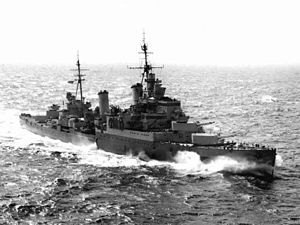HMS Sheffield (C24)

Sheffield underway in 1944
|
|
| History | |
|---|---|
|
|
|
| Name: | HMS Sheffield |
| Builder: | Vickers Armstrong |
| Laid down: | 31 January 1935 |
| Launched: | 23 July 1936 |
| Commissioned: | 25 August 1937 |
| Identification: | Pennant number: C24 |
| Nickname(s): | Shiny Sheff |
| Fate: | Scrapped at Faslane, 1967 |
| General characteristics | |
| Class and type: | Town-class light cruiser |
| Displacement: |
|
| Length: | 558 ft (170 m) |
| Beam: | 61 ft 8 in (18.80 m) |
| Draught: | 21 ft 6 in (6.55 m) |
| Propulsion: |
|
| Speed: | 32 knots (59 km/h) |
| Complement: | 748 |
| Sensors and processing systems: |
Type 79Y radar from August 1938 |
| Armament: |
|
HMS Sheffield was one of the Southampton sub class of the Town-class cruisers of the Royal Navy during the Second World War. She took part in actions against several major German warships. Unlike most Royal Navy ships of her time, her fittings were constructed from stainless steel instead of the more traditional brass. This was an attempt to reduce the amount of cleaning required on the part of the crew. Her nickname, the "Shiny Sheff", stemmed from this. A prototype radar system was placed into service in August 1938 on the Sheffield. It was the first vessel in the Royal Navy to be so equipped.
At the outbreak of war, Sheffield served with the 18th Cruiser Squadron, patrolling the Denmark Straits and then, in April 1940, she was engaged in the Norwegian Campaign. After a short spell carrying out anti-invasion duties in the English Channel, she joined Force H, based in Gibraltar. During that time, she operated in the Mediterranean and the Atlantic until the year's end, and took part in Operation White and the battle of Cape Spartivento.
In 1941, she participated in Operation Grog -the shelling of Genoa, in operations against Vichy convoys and supporting air reinforcements to Malta. In May, Sheffield took part in the sinking of the German battleship Bismarck, narrowly escaping a friendly fire torpedo attack by the aircraft carrier Ark Royal's Fairey Swordfish; Eleven torpedoes were dropped and only defective Duplex exploders and fine ship handling saved her from disaster. (In the report of the attack, Admiral Sir John Tovey, commanding Home Fleet, was told only no hits were scored on Bismarck. The reaction of Sheffield's crew "has not made its way into the official records".) On 12 June, she located and sank one of Bismarck's tankers, Friedrich Breme. After the destruction in early October 1941 of another German supply ship, Kota Penang, (aided by the cruiser Kenya), Sheffield returned to Britain.
...
Wikipedia
